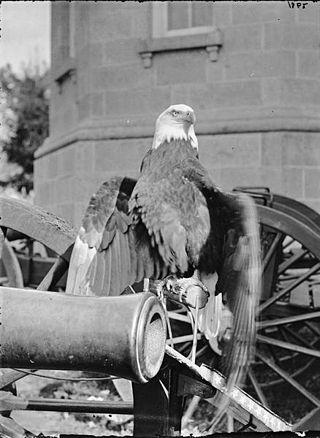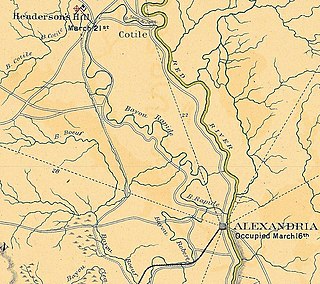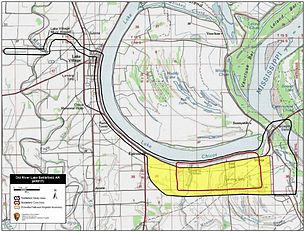The Battle of Cotton Plant also known as Action at Hill's Plantation or Action at Cache River or Action at Round Hill was fought during the American Civil War in Woodruff County, Arkansas. Frustrated in its attempt to march to Little Rock by a lack of supplies, the Union Army of the Southwest under the command of Samuel Ryan Curtis moved south down the White River. Curtis's army encountered a Confederate force led by Albert Rust on the east bank of the Cache River near Cotton Plant. Rust was only able to bring two Texas cavalry regiments into action. These horsemen attacked the Federal advance guard under Charles Edward Hovey, but after a spirited fight, Union reinforcements arrived and drove off the Texans. Rust's force made a disorderly retreat and Curtis's army was able to march south to Clarendon before veering east to occupy Helena on the Mississippi River.
The Battle of Devil's Backbone, also known as the Action at Devil’s Backbone, was a military engagement in the Trans-Mississippi Theater of the American Civil War. Devil's Backbone is a ridge in the Ouachita Mountains approximately 4 miles (6.4 km) southwest of Greenwood, Arkansas. The battle was fought on September 1, 1863, in Sebastian County, Arkansas. The Union victory ensured the safety of the Fort Smith garrison until the end of the war.

The Red River campaign, also known as the Red River expedition, was a major Union offensive campaign in the Trans-Mississippi theater of the American Civil War, which took place from March 10 to May 22, 1864. It was launched through the densely forested gulf coastal plain region between the Red River Valley and central Arkansas towards the end of the war. The offensive was intended to stop Confederate use of the Louisiana port of Shreveport, open an outlet for the sugar and cotton of northern Louisiana, and to split the Confederate lines, allowing the Union to encircle and destroy the Confederate military forces in Louisiana and southern Arkansas. It marked the last major offensive attempted by the Union in the Trans-Mississippi Theater.
The Battle of Prairie D'Ane, also known as the Skirmish at Prairie D'Ane, Battle of Gum Springs or Battle of Moscow, was fought in present-day Nevada County, Arkansas, as part of the Camden Expedition, during the American Civil War. The Camden Expedition was launched by Union forces as part of the Red River Campaign of 1864. U.S. planners envisioned two federal armies converging simultaneously, one force under the command of Maj. Gen. Nathaniel Banks pressing northward up the Red River commencing at Alexandria, Louisiana and the other federal army under the command of Maj. Gen. Frederick Steele driving southwestward from Little Rock, Arkansas. The objective was to press the rebel army of Gen. E. Kirby Smith back upon the rebel stronghold at Shreveport and defeat him. If successful, a somewhat vague second phase envisioned the two federal armies combining into one large force and continuing their offensive with a westward push into Texas.

The Battle of Chickasaw Bayou, also called the Battle of Walnut Hills, fought December 26–29, 1862, was the opening engagement of the Vicksburg Campaign during the American Civil War. Confederate forces under Lt. Gen. John C. Pemberton repulsed an advance by Union Maj. Gen. William T. Sherman that was intended to lead to the capture of Vicksburg, Mississippi.

Old Abe, a bald eagle, was the mascot of the 8th Wisconsin Volunteer Infantry Regiment in the American Civil War. Later, his image was adopted as the eagle appearing on a globe in Case Corporation's logo and as the screaming eagle on the insignia of the U.S. Army's 101st Airborne Division.

The Battle of Yellow Bayou, also known as the Battle of Norwood's Plantation, saw Union Army forces led by Brigadier General Joseph A. Mower clash with Confederate States Army troops commanded by Brigadier General John A. Wharton in Avoyelles Parish, Louisiana during the American Civil War. This was the final action of the Red River campaign in which a Union army under Major General Nathaniel P. Banks was repulsed by Confederate forces led by Major General Richard Taylor. The failed Union campaign almost ended in disaster when an accompanying Union fleet led by Rear Admiral David Dixon Porter was trapped at Alexandria, Louisiana, by low water in the Red River. An engineering feat saved the fleet, allowing Banks' army to complete its withdrawal.

Colton Greene was an American businessman and soldier. He served as a Confederate general during the American Civil War, mostly leading cavalry units. After the war he pursued several successful civic projects and public functions in Tennessee.
The Battle of Richmond was fought on June 15, 1863, near Richmond, Louisiana, during the Vicksburg campaign of the American Civil War. Major General John George Walker's division of Confederate troops, known as Walker's Greyhounds had attacked Union forces in the Battle of Milliken's Bend and the Battle of Lake Providence earlier that month in hopes of relieving some of the pressure on the Confederate troops besieged in Vicksburg, Mississippi. While both of Walker's strikes were failures and the Confederates withdrew to Richmond, Union Major General Ulysses S. Grant still viewed the presence of Walker's men at Richmond to be a threat. On June 14, the Mississippi Marine Brigade and the infantry brigade of Brigadier General Joseph A. Mower were sent to attack the Confederates at Richmond.

The Battle of Bentonville was fought in Johnston County, North Carolina, near the village of Bentonville, as part of the Western Theater of the American Civil War. It was the last battle between the armies of Union Maj. Gen. William T. Sherman and Confederate Gen. Joseph E. Johnston.
The Battle of Bayou Meto, also known as the Battle of Reed's Bridge, was fought near present-day Jacksonville, Arkansas, along the Bayou Meto River, on August 27, 1863. During the American Civil War, Union forces left Helena, Arkansas, to move against the Confederate-held state capital of Little Rock. Part of the Union command, under Brigadier General John W. Davidson, defeated Confederate cavalry commanded by Brigadier General John S. Marmaduke on August 25, in the Battle of Brownsville. After the action at Brownsville, the Confederates fell back to the Bayou Meto. Union attacks on August 27 succeeded in pushing Marmaduke's men back across the bayou, but were unable to break the Confederate line. Davidson withdrew back to Brownsville after the fighting. The Union advance resumed on September 6, and Little Rock surrendered on September 10, after the Battle of Bayou Fourche. Tensions exacaberated during the action at Bayou Meto contributed to the Marmaduke-Walker duel, during which a Confederate general was killed. In 2002, part of the battlefield was listed on the National Register of Historic Places as the Bayou Meto Battlefield.
The Battle of Brownsville was fought on August 25, 1863, near what is now Lonoke, Arkansas, between Union forces led by Colonel Washington Geiger and Confederate troops under Brigadier General John S. Marmaduke. Union forces commanded by Major General Frederick Steele were advancing from Helena, Arkansas, towards Little Rock, the state capital of Arkansas. Confederate Major General Sterling Price ordered cavalry led by Marmaduke and Brigadier General Lucius M. Walker to Brownsville in response to the Union advance.
The Skirmish at Terre Noire Creek, also known as the Skirmish at Wolf Creek or Skirmish at Antoine, an engagement during the Camden Expedition of the American Civil War, was fought on April 2, 1864. The action occurred about 1 mile (1.6 km) east of Terre Noire Creek along a defile near the towns of Hollywood, Arkansas and Antoine, Arkansas. A Confederate States Army cavalry brigade under Brigadier General Joseph O. Shelby attacked a Union supply train of more than 200 wagons accompanying Union Army Major General Frederick Steele's force which was attempting to reach Shreveport, Louisiana to join with Major General Nathaniel Banks's force in the Red River Campaign with the objective of occupying Shreveport and controlling western Louisiana.
The Skirmish at Ashley's Mill, also known as the Skirmish at Ferry Landing was an engagement that was fought between Union Army and Confederate States Army cavalry regiments in Arkansas on September 7, 1863 during the American Civil War. Union Brigadier-General John W. Davidson commanding the cavalry division of the Union Army of Arkansas sent the 7th Missouri Volunteer Cavalry Regiment as his lead regiment to clear the 5th Arkansas Cavalry Regiment, under the temporary command of Major John Bull while Colonel Robert C. Newton was in temporary brigade command, from its position guarding a crossing of the Arkansas River near Little Rock, Arkansas. The Union cavalry forced the Confederates to retreat which opened the route to the east of the river, leading to the Battle of Bayou Fourche on September 10, 1863 and the capture of Little Rock by the Union Army of Arkansas under the command of Major General Frederick Steele. The Confederate regiment's casualties were 1 killed, 3 wounded and 2 captured while the Union regiment reported no casualties.
The 3rd Missouri Cavalry Regiment was a cavalry regiment of the Confederate States Army during the American Civil War. It was also known as Greene's Regiment after its commander, Colonel Colton Greene.

The 18th Texas Infantry Regiment was a unit of volunteers recruited in Texas that fought in the Confederate States Army during the American Civil War. The regiment was enrolled in Confederate service in May 1862 and always campaigned west of the Mississippi River in the region known as the Trans-Mississippi Department. The unit was assigned to the Texas infantry division known as Walker's Greyhounds. The regiment fought at Milliken's Bend, Richmond (La.), and Bayou Bourbeux in 1863 and Mansfield, Pleasant Hill, and Jenkins' Ferry in 1864. The regiment disbanded in mid-May 1865, but its formal surrender date was 26 May 1865.

The Battle of Henderson's Hill or Bayou Rapides saw a reinforced Union Army division led by Brigadier General Joseph A. Mower opposed by a regiment of Confederate Army cavalry and attached artillery under Colonel William G. Vincent. That evening, during a rainstorm, Mower sent one infantry brigade on a circuitous march to gain the rear of Vincent's command. The brigade's subsequent attack surprised and captured most of the Confederates. Mower could not exploit his minor victory because the arrival of additional Federal army and naval units was delayed. This clash occurred during the Red River campaign of the American Civil War which saw Major General Nathaniel P. Banks' Union army try to seize Shreveport, Louisiana, from its Confederate defenders led by Lieutenant General Richard Taylor.

1st Texas Field Battery or Edgar's Company was an artillery battery from Texas that served in the Confederate States Army during the American Civil War. The artillery company formed in November 1860, but was not formally taken into Confederate service until April 1861. The unit participated in the disarming and surrender of United States soldiers and property in Texas in early 1861. The battery marched to Arkansas where in 1862 it joined the infantry division known as Walker's Greyhounds. The battery fought at Milliken's Bend and Richmond (La.), shelled a Federal river transport, and campaigned in south Louisiana in late 1863. The 1st Texas Battery was captured at Henderson's Hill in March 1864. The soldiers were later exchanged, and the unit disbanded in 1865 at the end of the conflict.
The Little Rock campaign saw Union forces capture Little Rock, Arkansas during August and September 1863, as part of the American Civil War. Union forces led by Major General Frederick Steele advanced from Helena, Arkansas, beginning on August 10, before joining cavalry commanded by Brigadier General John W. Davidson at Clarendon on August 15. Steele sent Davidson to move against the Confederates, while he pulled his infantry to establish a base at DeValls Bluff. Davidson's men fought with Confederate cavalry commanded by Brigadier Generals Lucius M. Walker and John S. Marmaduke at Brownsville on August 25 and Bayou Meto on August 27 before the Confederates withdrew closer to Little Rock.

The 2nd Louisiana Cavalry Regiment was a unit of mounted volunteers recruited in Louisiana that fought in the Confederate States Army during the American Civil War. Breazeale's Cavalry Battalion was formed in July 1862 and was augmented by five additional companies in September 1862 to form a regiment. It served for the entire war west of the Mississippi River in the Trans-Mississippi Department. The regiment fought at Georgia Landing, Fort Bisland, Irish Bend, and Brashear City in 1863 and Henderson's Hill and Mansfield in 1864. Afterward, the regiment fought in minor skirmishes before the Trans-Mississippi's final surrender on 26 May 1865.











